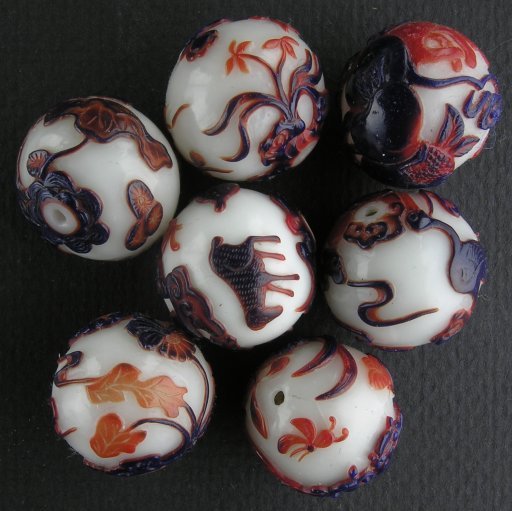Last time I spoke a little about casing, but didn't explain what it was. For a lampworker to case a bead means to cover the base bead with another layer of clear. Clear colorless is the most common choice, as it magnifies the design below and adds depth to the design. In this case however (pun intended) a white bead was first encased with opaque red and then cobalt blue.
Beads are usually only encased in opaques if they're to be cold-worked later. The US (glass) beadmaking scene does not have much carving going on, though gemcutters have been cutting beautifully wrought ‘fantasy cuts’ for some number of years, as well as carving stone. Glass simply doesn't have a great enough intrinsic value for artisans to put that kind of time into it; besides which we just don't seem to have the same tradition of making small finely carved objects such as obijime or netsuke (which admittedly are Japanese) out of non-precious materials such as wood or bone.
Western beadmakers do, however, grind beads: chevrons are the traditional example, and more elaborate pieces, with faceting patterns crossing over from the lapidary world, are starting to appear. Diana East has made a name for herself with her intricate sand-blasted beads, which also depend on removing surface layers. So it will be interesting to see where these cold-working techniques go, as they are currently employed by only small subset of glass beadmakers. My guess is that easy (i.e. inexpensive) availability of air-driven tools (similar to dentists’ drills) is the thing most likely to spur interest.
In the meantime we have these chinese examples, with traditional motifs of various animals, real and mythical; clouds; and vegetation—all symbols of the natural world. And if you look at the bead in the bottom right of the picture, you can see two interesting features about the bead. One I will discuss next time: the other, a crack is that bane of all beadmakers.
Glass beads crack from impact (that is, I might have dropped it on too hard a surface), from incompatibility (glasses contracting at differing rates as a piece cools) and from heat shock (as from a hot drill bit on an insufficiently cooled bead, which can be avoided by working the bead under water, or some other cutting agent, to keep it cool.)
file created 08oct06
Unless otherwise noted, text, image and objects depicted therein copyright 1996--present sylvus tarn.
Sylvus Tarn